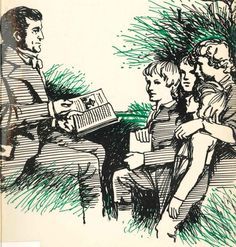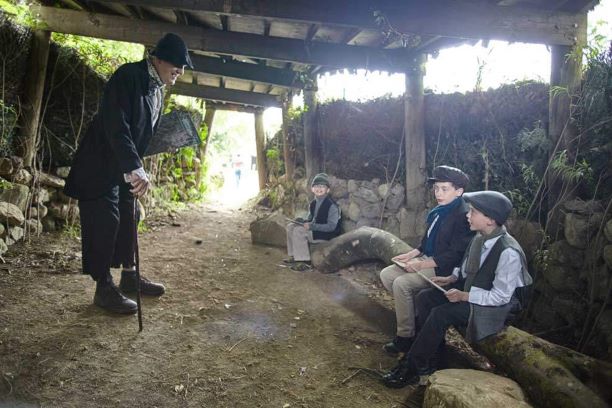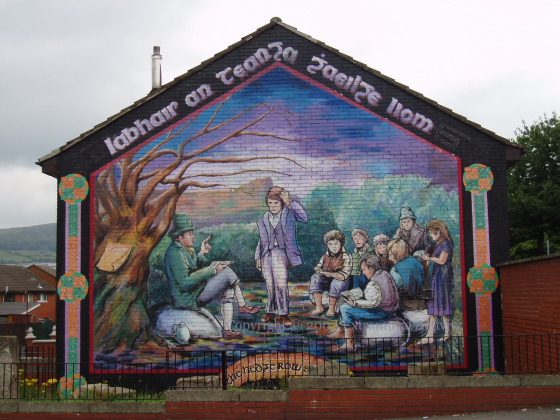What is a Hedge School?
The hedge schools were a very informal, unofficial, very local, and very ILLEGAL system of education in Ireland for about 200 years.
First, the back story
The Irish had a system of education for hundreds of years. Usually referred to as bardic schools, these were secular schools, taught in the Irish language, with a focus on language, literature, history, culture, and Brehon law. Often conducted by bards, but as often by storytellers and sometimes musicians.
When Oliver Cromwell came to Ireland in the mid-1600s, he outlawed bardic schools. (He also ordered the massacre of Irish people and the confiscation of lands from the Irish, which doesn’t make him a very well-liked guy in Irish history. He’s not very well liked in English history either, for that matter.) Cromwell called the bardic schools popish schools, not because they taught religion but, in his words, they taught superstition, idolatry and evil Celtic customs.
A few decades later, when William of Orange was the British king, the British enacted the penal laws. These banned Catholicism and banned priests, which of course banned the teaching of Catholicism, whether in church or school, or anywhere else, for that matter.
Thus by law, “no person of the popish religion shall publicly or in private houses teach school, or instruct youth in learning“.
The English sponsored schools in Ireland, particularly in cities and towns, and the Catholic Irish could be exposed there to mathematics, science, and English language instruction. But many Irish refused to use them. Instruction often included Protestant religio and denigration of Irish history and customs.
The illegal schools
Did this mean the Irish went without schools? NO

It led to a very unorganized, entirely local system of schools. These were sometimes called secret schools, sometimes pay schools, and other names. The most common name, though, was hedge schools.
Local people found or recruited or hired a teacher. The teacher and the students met secretly – anywhere out of sight of local officials and beyond the purview of the English. This was often in a barn or in someone’s parlor, or an abandoned hut. They gathered out of town – on a riverbank, or in a grove of trees, or behind a row of hedges. Which is how they became known as hedge schools
Usually, one student or a parent acted as a lookout – looking for law enforcement or an informant. The schools wouldn’t always meet at the same place and moved about to avoid detection.

A hedge School did not have a faculty. It had a single teacher, usually called the headmaster. The headmaster was sometimes paid a shilling or two, usually provided a place to stay, and given handouts of food by the locals. Even the poor would find something to spare so that their kids could go to school.
What were the kids taught?
There were some priests acting as headmasters, so some religion was taught. But the hedge schools were largely secular schools. The focus was on reading, writing, arithmetic, history, geography – all in the Irish language.
Students were taught whatever the headmaster knew. This sometimes included the classics – in Latin or Greek.
A journal entry from a French man, was traveling in Ireland in the late 1700s, noted an encounter with an Irish boy. The boy was dressed in rags and with bare feet. The French man spoke with the boy, who did not speak any English, but the French man knew a little Irish. The French man was shocked to discover that the boy could recite poetry in Latin, and that the boy could quote the work of ancient Greek scholars.
The licensed schools
In the late 1700s the penal laws were eased somewhat. A school could be established, but it required a license granted by the local Anglican bishop. The bishop could grant, or withdraw, a license at will.
Catholic parishes set up schools under this system with such a license. This led to a dramatic shift in official church attitude: one could be a good Catholic and a loyal British subject at the same time. These schools taught religion and the 3Rs, but they also taught people to obey the laws of the British. And they taught in the English language.
There remained many Irish families who couldn’t agree with this approach. And so the hedge schools continued. These remained entirely secular with no cooperation from the church. The hedge schools continued to teach in the Irish language, with the focus, besides the 3Rs, on Irish history, Irish culture and Irish literature.
The decline of the hedge schools
The number of hedge schools began to decline after 1829 with the Catholic Emancipation Act, which, among other things, gave Catholics the right to vote. The movement grew in mid-1800s, not only in Ireland but in England and America, for free public education. Catholic parishes set up their own schools and, perhaps ironically, priests and church officials became the most vocal critics of hedge schools. The number of hedge schools declined through the balance of the century.
But that certainly does not negate the importance, and the influence, of the Hedge schools when they did exist. One estimate suggested over 400,000 children attended hedge schools in the 1840s, in perhaps as many as 9,000 different schools.

Every Irish festival in North America has a cultural area, operating under various names. Many of these are called the hedge school, and I’ve done many presentations at a festival hedge school. I am indeed proud to call myself a hedge school headmaster.
The images, from top to bottom, are a photograph of a mural in a Belfast neighborhood, depicting a hedge school, a 19th Century illustration of a hedge school, an illustration of a headmaster with his students, and a photograph of a living history exhibit at Dún na Sí Amenity & Heritage Park in County Westmeath.
